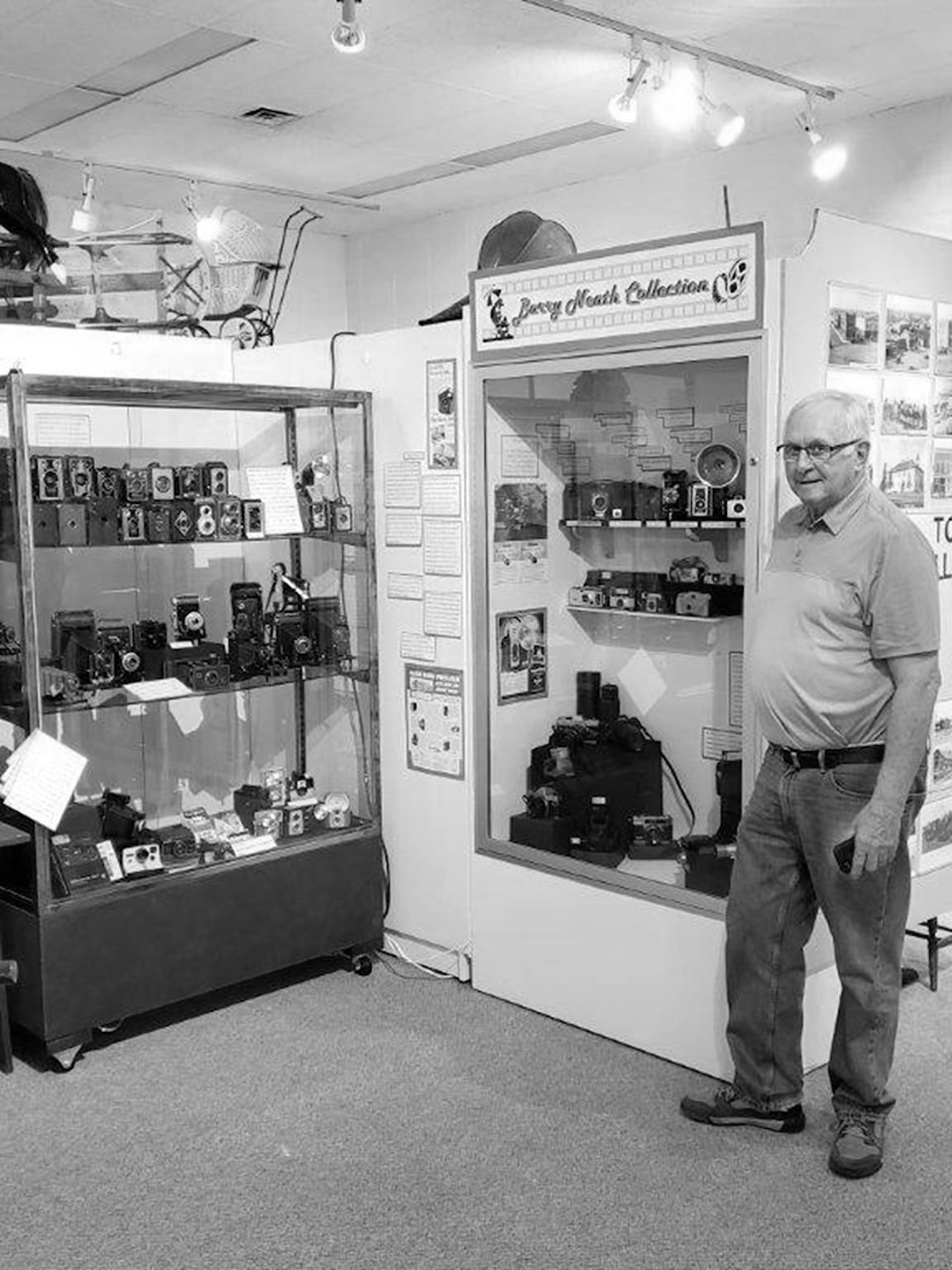In 1985 Barry Neath was very busy raising a family, managing the Ponoka Co-op Shopping Centre, getting involved in volunteering with many community organizations and activities, as well as making lots of friends along the way. Among his favourite acquaintances were Ed and Tania Nelson, a congenial couple who loved to visit and have fun, and share a few good jokes and local news in their spare time, while Ed collected just about anything he could store or display in his basement or garage.
One day they were all sitting at a local Van Eaton auction when Ed challenged his good buddy to start collecting something neat and nice as a new hobby, so Barry responded by browsing around the sale and finally purchased a big box of old cameras for $5. He also really liked photography so he just kept seeking out the cameras and got some more from friends and neighbours, then snapped lots of photos with those that still worked, and made a promise that he would never sell them. Over the years Neath has managed to collect over 250 cameras, the oldest being a 1900 Box Model, and most of his amazing early collection used sheet negatives, glass negatives, and 620 film, which all had to be changed and developed in a dark room and whether they were masterpieces or duds you had to pay for all that you took.
This month Barry graciously donated all of his classic collection to the Fort Ostell Museum for all to see, starting this summer and long into our future generations. He put out a challenge to folks of all ages stating that many of the cameras from this collection are so old that not too many will be able to admit that “I used to have one of those.” Here are some of the colourful 100-plus years of highlights and facts from this unique camera collection, which everyone is invited to drop in and see Monday to Friday from 10 a.m., as well as browsing through the rooms full of artifacts and memories of the heritage and history of our friendly town and county of Ponoka.
Believe it or not, the wonderful world of photography all began when the first photograph was made by Joseph Niepce in 1822, and he would later develop the process known as Heliography. Englishman Henry Fox Talbot created a paper in 1840 that was sensitive to light that would become known as negatives or calotype, which is Greek for “beautiful picture.”
George Eastman would become the founding entrepreneur of the photography industry in 1880, producing and selling dry plates and then acquiring the patents for roll film, and then much later coming out with 35 mm film. On September 4, 1888 Eastman registered the name “Kodak” and in the same year Kodak No. 1 became the Eastman Kodak Company’s first official box camera, which sold for $1 and would set the trend for the massive production of cameras for the next 50 years. What would develop from these ever-changing developments and exciting new family and professional products would be the amazing milestones of the photography industry. Along the way the world was thrilled about the introduction of the first folding camera, pocket camera, and the extremely popular Kodak Brownie camera, which was named after a comic book character and was sold with the film already inside. After the film was completed you left it in the camera, dropped it off at the camera shop, or mailed it into the camera shop to be developed and was then returned with the developed photos along with a new film, which cost 15 cents. George Eastman died in 1932 after building one of the largest photographic companies in the world, as well as also supporting the looming threat of another World War by agreeing to produce hundreds of thousands of hand grenades. Kodak’s first automatic camera would hit the very lucrative and competitive market in 1959, then came the affordable instamatic camera in 1963, the first digital camera in 1975, and then added a whole new line of technical gadgets and advances to try and keep up with the booming industry going into the 20th century. Although having to apply for bankruptcy protection in 2012, the Kodak Company are still going strong and proudly approaching their 140th year of serving millions of customers throughout North America and the world, currently producing the Ektra phone with Android, the Super 8 camera, and the Archos tables, as well as being involved in the business of packaging, printing, film, and graphic communications.
What visitors will see when they visit the Barry Neath camera collection is a unique variety of early wooden, leather, and plastic cameras, along with added accessories such as flash bulbs, Polaroid’s, the early home movie picture cameras, and the first battery powered camera, which could produce 60 second videos.
Over the years Neath really enjoyed his hobby of collecting cameras and would meet lots of interesting people along the way. Most interesting was the story behind his 1915 bellows camera, which he acquired from a nephew in Saskatchewan and has a real history behind it! Apparently a farmer’s daughter in North Battleford, Saskatchewan way back then wanted to marry the hired man, but the old dad said no, and after giving his sweetheart a camera he left for WWI, he never returned, she was heartbroken and would never marry. Many years later a nephew dug the camera out of a box and passed it all on to Barry. We can only imagine what countless wonderful stories and images these cameras must have captured over the years, and can’t help but wonder just how many of those cherished family photos are still packed away in a trunk or in tattered old photo albums in the attic, and just waiting to be discovered and shared to the joy of our past and future generations?
